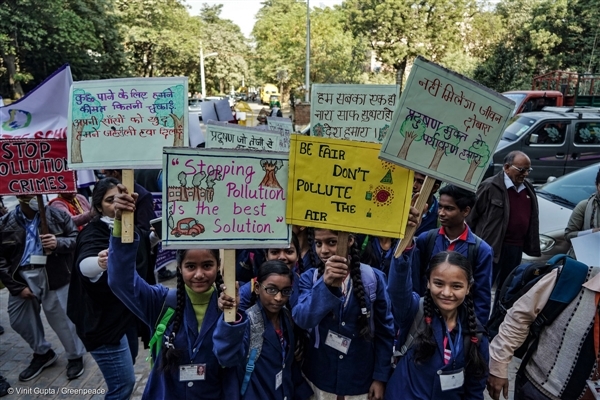How many times must civil society organisations, residents and children, pay a visit to the Environment Ministry of India until something is actually “done” about the air pollution crisis? As a country, we’ve already seen more than a million deaths as a result of outdoor air pollution and it has even cost our economy. Today, as the long term action plan for Delhi-NCR continues to be in the “discussion” phase, the rest of the country has been virtually left out in the cold.

So what is the problem?
Continuous air quality monitoring stations help people take informed decisions on polluted days. But according to a recent Airpocalypse II report, there is a significant lack of data in 23 states in-spite of monitoring stations having doubled across the country. And there is still a lack of access to captured data in many cities. Such inadequate data has reflected in regulatory decision making for source-wise emissions – like regulating old and polluting power plants, vehicles that have not been shut down on time, efficiency of thermal power plants that have not been improved, and biomass burning.
When comparing China’s robust network of 1500+ stations and a transparent public sharing platform, India has only 87 continuous monitoring stations across – a condition that needs to change sooner than later.

Comparison of facts on air pollution around the world
| India | China | US | European Union | |
| Change in satellite based PM2.5 levels from 2010 to 2015) – | +13% | -17% | -15% | -20% (from 2005 to 2013) |
| PM2.5 trend | Increasing steadily for past 10 years; 2015 was the worst year on record | Falling since 2011; 2015 was the best on record | Falling since measurements started | Falling since measurements started |
| PM2.5 in capital city, annual (µg/m3) | 128 | 81 | 12 | 18 |
| PM2.5 air quality standard, annual (µg/m3) | 40 | 35 | 15 | 25 (from 2020, 20) |
| Deaths per day from air pollution in 2013 | 1800 | 2700 | 250 | 640 |
| Online PM2.5 monitoring | 39 stations in 23 cities (as of Feb 2016) | 1,500 stations in 900 cities & towns | 770 stations in 540 cities & towns | 1,000 stations in 400 cities & towns |
| Share of thermal power plants with basic pollution controls (desulphurization, particle controls) | 10% | 95% | 60% | 75% |
| Deadline for meeting national air quality standards | None | 2030; most key cities have an interim target for 2017 | 2012; violating areas are currently implementing new plans | 25 by 201520 by 2020 |
| Consequences for missing targets | None. Courts however, do impose penalties for non-compliance from time to time | Promotion of province governors depends on meeting targets | States must adopt emission reduction measures into law that are demonstrated to enable meeting targets; must account for pollution transport into downwind states; periodic review | Cities & countries face legal action for not meeting standards |
So then, what does the available and accessible data point to?
A list of 280 cities that have data for particulate matter 10 (PM10) pollutants – violate annual safe limits of 60μg/m³ (not so safe when compared to WHO standards- 20μg/m³). As of now, 18 crore Indians, including 1.7 crore children under the age of 5, live in areas where the air pollution levels are more than twice the prescribed clean air standards. Many of these critically polluted cities point to the need for strict emergency response plans for sourcewise release of pollutants – that are more immediate, short-term and time bound.
We can beat airpocalypse only if pollution levels are assessed widely and regularly and if there are clear reduction targets for regions, along with penalties for any non-compliance by governments and corporations. Clean air in India can only be a reality if the government understands that the air pollution crisis is not just centered to Delhi-NCR, but all of India, and if we as the public – choose to move towards solar rooftops, energy efficient appliances that can reduce household energy usage, public transport, cycling and walking, and reducing waste generated at our own houses – thereby reducing burning of waste at streets and landfills.

It’s time to buckle down and get cracking on the already formulated National Clean Air Programme.
Sign up and own a digital copy of the second edition of the Airpocalypse report.
Find out what the report says about your state/city today.
Grace Saji works in the Digital Engagement team at Greenpeace India



